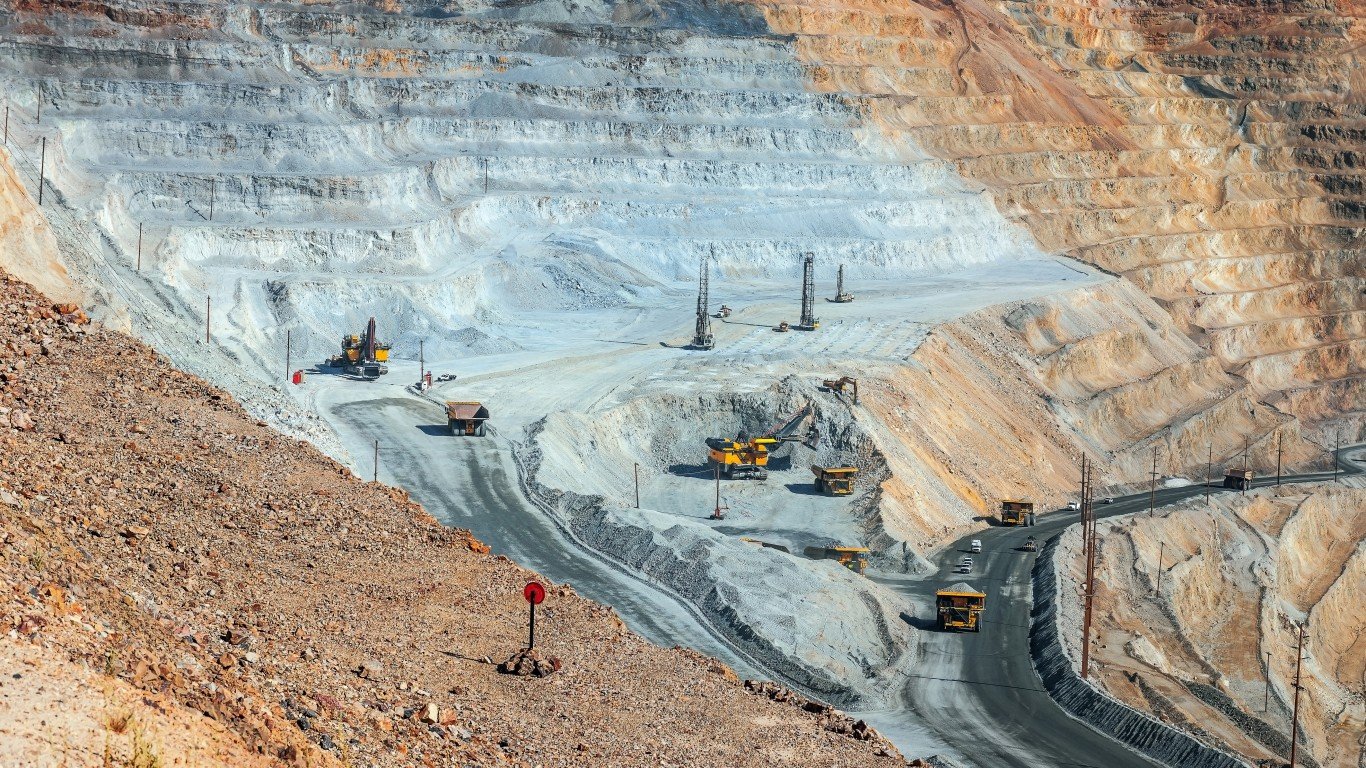

One could argue that the most precious metal being mined these days is lithium. The commodity price of lithium increased by about 400% over the past year, while the price of gold rose by just 4.3%. Shares of four top lithium miners increased in value by about 47%, all the way up to a jump of nearly 315%. None of these miners pays a dividend, however.
[in-text-ad]
Just over half of gold-mining companies do pay a dividend, as do three of four copper miners and three of seven silver miners. Miners of other industrial metals, like aluminum and iron ore, often pay dividends as well.
We wanted to look at the miners that pay the highest dividends. We found five that pay a dividend yield of more than 6%.
Vale
Brazil’s Vale S.A. (NYSE: VALE) produced 300 million metric tons (tonnes) of iron ore in 2020, more than any other company in the world. Brazil trails only Australia as the location of the world’s largest reserves of iron ore, a critical component of steel. Vale is targeting iron ore production of 400 million tonnes this year.
Vale’s share price has dropped by about 8.6% over the past 12 months, including a year-to-date gain of more than 18%. The company has missed analysts’ revenue estimates in each of the past four quarters and beaten the earnings estimate in the last two of the four periods. This is not exactly a stellar record.
Last month, the company announced it would repurchase up to 500 million shares (about 10% of shares outstanding) over a period of 18 months, a program worth about $8.3 billion when it was announced. Combined with a production increase of about 33% and an expected price increase due to the Russian invasion of Ukraine, even coronavirus-related lockdowns in China are unlikely to have a significant impact on the company’s performance this year.
Then there’s the dividend yield of 13.61% that Vale pays in semi-annual installments. Daily trading volume has averaged around 43.3 million shares for the past 10 days, and the company’s payout ratio is nearly 61%. Free cash flow for the past 12 months totaled $17.72 billion.
Rio Tinto
London-based Rio Tinto Group (NYSE: RIO) mines aluminum, copper, diamonds, gold, borates, titanium dioxide, salt, iron ore and lithium at operations all over the world. The company is the world’s second-largest iron ore miner, primarily coming from Rio’s Australian mines. It owns a high-grade lithium development project in Serbia that has had its permits revoked by the government, but the company is still hopeful it can overcome opposition to the project. The company also owns and operates copper mines in Mongolia, Utah and Arizona.
In its operational review for the March quarter, Rio reported lower iron ore shipments both sequentially and year over year. Copper shipments were down 5% sequentially but up 4% year over year. In March, Rio Tinto offered to pay $2.7 billion for the 49% of Turquoise Hill Resources’s Mongolian copper and gold mine.
March quarter copper production at Turquoise Hill was down 33% year over year and 22% sequentially, while gold production fell by 60% year over year and 25% sequentially. The company expects fiscal 2022 copper production of 110,000 to 150,000 tonnes and gold production of 115,000 to 165,000 ounces.
Rio Tinto’s dividend yield is 11.15%, and its daily trading volume is around 4.5 million shares. The mining giant’s payout ratio is about 52%, and its free cash flow for the past four quarters is $17.96 billion.
Sibanye Stillwater
South Africa-based Sibanye Stillwater Ltd. (NYSE: SBSW) mines precious metals, primarily gold and platinum group metals (PGM) in South Africa, Zimbabwe, Canada, Argentina and Montana. The company’s South African gold operations have been targeted since March by miners striking for a monthly pay increase of $12.62. About 30,000 people work at the three mines affected by the strikes. Negotiations have been ongoing and a meeting was scheduled for Thursday.
[in-text-ad]
In Montana, Sibanye Stillwater operates the only platinum mine and platinum recycling operation in the United States. While gold prices have been down about 4% over the course of a year, platinum prices have fallen by nearly 22%.
The company’s March-quarter operations update reported gold production had fallen by nearly half, both sequentially and year over year. The average gold price was about 5.5% higher, but all-in sustaining costs rose by almost 50%. PGM production was about 4% lower sequentially and more than 20% lower year over year. The average basket price for PGMs was down about 17% year over year and all-in costs were essentially flat.
Sibanye Stillwater pays a dividend yield of 9.22%. Daily trading volume is around 3.8 million shares, and the company’s payout ratio is about 55%. Free cash flow for the past 12 months totaled $2.36 billion.
BHP
Australia-based BHP Group Ltd. (NYSE: BHP) is the world’s third-largest iron ore miner and among the globe’s top producers of copper and coal as well. BHP produced about 370,000 tonnes of copper in the March quarter and about 60 million metric tons of iron ore. Copper production was up 1% sequentially and iron ore production down 10%. BHP’s metallurgical coal production rose by 20.6 million tonnes (up 20%) and thermal coal production rose by 13% to 2.6 million tonnes
BHP is expecting the sale of its petroleum business to Australia’s Woodside Petroleum to be completed on June 1. The sale marks the end of BHP’s extraction of oil and gas. The company expects its 2022 fiscal year (ending in June) copper production to fall into a range of 1.57 million tonnes to 1.62 million tonnes. Iron ore production is tabbed at 249 million to 259 million tonnes.
BHP’s dividend yield is 10.39%, and the company’s payout ratio is nearly 90%. About 4.7 million shares are traded on an average day. BHP’s free cash flow for the past year is about $24.1 billion.
Southern Copper
Southern Copper Corp. (NYSE: SCCO) produces copper and molybdenum from mines in Peru, Mexico, Argentina, Ecuador and Chile. It is the world’s fifth-largest producer, trailing Chile’s Codelco, BHP, Freeport-McMoRan and Glencore. In 2020 the company produced more than 1 million tonnes of copper.
In the first quarter of this year, Southern sold nearly 208 million tons of copper, down 13.4% year over year. Sales of silver declined by 16.8% to 4.4 million ounces. The company’s average selling price for copper was around $4.54 per pound (up 17.6% year over year), while silver fetched an average of $24.05 per ounce (down 8.5% year over year).
Southern pays a dividend yield of 6.43%, and the payout ratio is 72.8%. Shares are fairly lightly traded, with about 1.1 million changing hands on average every day. The company’s free cash flow for the past four quarters totaled $3.47 billion.
Sponsored: Find a Qualified Financial Advisor
Finding a qualified financial advisor doesn’t have to be hard. SmartAsset’s free tool matches you with up to 3 fiduciary financial advisors in your area in 5 minutes. Each advisor has been vetted by SmartAsset and is held to a fiduciary standard to act in your best interests. If you’re ready to be matched with local advisors that can help you achieve your financial goals, get started now.
Thank you for reading! Have some feedback for us?
Contact the 24/7 Wall St. editorial team.
 24/7 Wall St.
24/7 Wall St.


